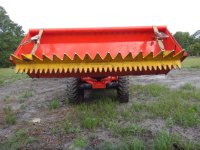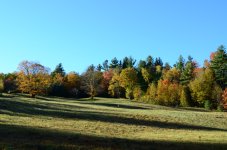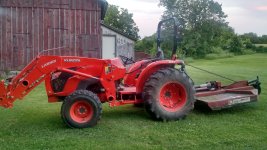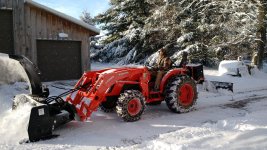Bullwinkle123
Platinum Member
Keywords: ballast, tire type, lawn preservation.
I have these applications for a new tractor I plan to buy, which are somewhat at odds with each other in terms of weight and tire requirements. However I only get one tractor, so need to figure out the best compromise. My tentative plan is to have unfilled R4's, curious to hear what you recommend.
Here are my _primary_ applications:
So on the one hand, we have the driveway repair with gravel in the bucket and rear weight is important. Is the blade enough? Or do I need wheel weights too? I'd kind of like to avoid loaded tires, but realize that's another option.
On the other hand, I'll occasionally be on the lawn with mulch in a bucket, brush in a grapple, or perhaps a cart in tow, and it's imperative I don't kill the grass. I.e the tractor is my occasional lawn cart. So R1 ag tires are probably out.
On the third hand (the gripping hand...) I need traction for the brush hogging field work. Ag tires would be preferred, but I'm hoping that R4's are good enough and might not kill the grass for the lawn crossings. The field has muddy parts, but mostly I'll try to time it when it's dry in the fall. Nobody has ever had issues getting stuck. They _do_ observe a pretty strict uphill/downhill travel pattern though due to the incline. I don't know what angle the incline is.
So one tractor, many needs. What's the best approach?
Miscellaneous notes.
I have these applications for a new tractor I plan to buy, which are somewhat at odds with each other in terms of weight and tire requirements. However I only get one tractor, so need to figure out the best compromise. My tentative plan is to have unfilled R4's, curious to hear what you recommend.
Here are my _primary_ applications:
- Once a year, maybe more, I need to brush hog a very rough and sloped field. I'm planning on a 6 foot rotary cutter. The saplings aggressively take root each year, otherwise we leave the undergrowth for the animals (scrub blueberries, blackberries, wild strawberries). There are occasional pits pits (1.5-3 feet in diameter, depth proportional to width) and stone outcroppings in the field if you aren't careful. The field is 5 acres.
- Once every couple of years I need to do gravel driveway repair, though maybe having the tractor will change the frequency. This is relatively level (but beware ditch to the side), and will involve a lot of FEL and rear blade work with dense gravel. Driveway at a guess is 500'.
- Tractor will be used to haul mulch to flower beds _ACROSS THE LAWN_ and haul away flower bed debris. It's very important not to hurt the grass, but the traffic will hopefully happen only twice a year. Other lawn driving (different locations) for spring/fall/storm cleanups as needed (lawn is surrounded by forest, trees fall). Lawn is a little over 1 acre.
- TBD: I may buy something like a wallenstein chipper/shredder, though whether I'd haul the shredder to the trees/brush or the trees/brush to the shredder I don't yet know.
So on the one hand, we have the driveway repair with gravel in the bucket and rear weight is important. Is the blade enough? Or do I need wheel weights too? I'd kind of like to avoid loaded tires, but realize that's another option.
On the other hand, I'll occasionally be on the lawn with mulch in a bucket, brush in a grapple, or perhaps a cart in tow, and it's imperative I don't kill the grass. I.e the tractor is my occasional lawn cart. So R1 ag tires are probably out.
On the third hand (the gripping hand...) I need traction for the brush hogging field work. Ag tires would be preferred, but I'm hoping that R4's are good enough and might not kill the grass for the lawn crossings. The field has muddy parts, but mostly I'll try to time it when it's dry in the fall. Nobody has ever had issues getting stuck. They _do_ observe a pretty strict uphill/downhill travel pattern though due to the incline. I don't know what angle the incline is.
So one tractor, many needs. What's the best approach?
Miscellaneous notes.
- The tractor will never be used to mow the lawn. I will do my best to keep it off the lawn, but the layout of my environment is such that I will have to drive across it more than I'd like. Not every use, but as noted above for cleanups and things.
- I may use the tractor for some minimum skidding. Decisions there are still pending, but I'm not planning to scale up my tractor purchase for serious skidding purposes. That's just a whole other can of worms.
- I'm looking at tractors with minimum 30 PTO HP, but haven't quite figured out what I need yet beyond that. Generally eyeing the 37-47 general HP categories of Kubota and Deere (as those are the dealers nearest me). So we're probably looking at a minimum 3000 lb machine.





